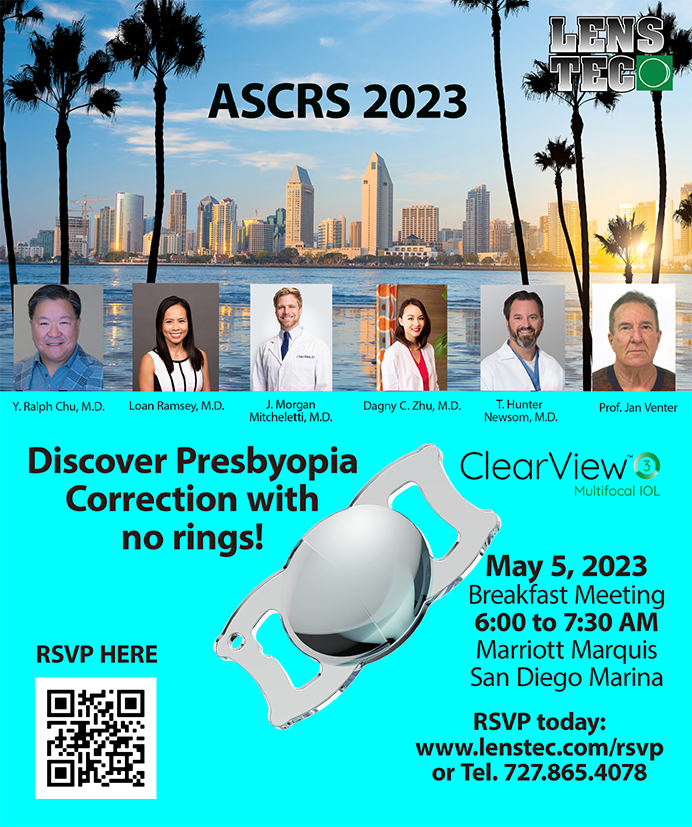Aug 2005
5 Questions With Manus C. Kraff, MD
Dr. Kraff reflects on the transitions ophthalmology has undergone and contemplates those that may come.
Manus C. Kraff, MD
What was the concept behind the establishment of the ASCRS? As one of the original founders of the society in 1975, my colleagues and I were driven by a desire to launch an organization that could represent the interests of a large group of ophthalmologists who had no other representation. Many ophthalmologists were interested in learning about implanting IOLs, but the existing organizations would not give them a forum for discussion, a platform for presenting information, or access to a journal in which to publish studies that were being conducted. At that time, the majority of information on IOLs was anecdotal, and innovation was a bad word, unless it came out of academia. Clinical ophthalmologists were not supposed to be innovative. They were expected to use only “tried and true” methods for treating their patients. The society was formed to satisfy a need that was not being met in ophthalmology.
What impact has the ASCRS had globally? When the ASCRS was originally formed as the American Intraocular Implant Society (AIOIS), the organization was immediately accepted, because it provided a journal and a meeting for physicians to attend if they wanted to be exposed to new technologies in implantation. In the succeeding years, other international societies were formed using the ASCRS as their model. With this network in place, it has become much easier to gain access to information and technology from around the world.
What led to your research on the topic of ACIOLs versus PCIOLs and the unjust classification of ACIOLs as inferior? ACIOLs were first introduced in Europe by Barraquer and Danheim in the early 1950s, but they proved to be disastrous after a short period of years. Peter Choyce, MD, kept this technology alive with his work in England through the 1960s, and Charlie Kelman, MD, developed innovative angle-supported lenses in the US during the late 1970s and early 1980s. I have been implanting ACIOLs since 1976. Initial problems with the IOLs, such as UGH syndrome, developed in the US because of inadequate manufacturing techniques. A second wave of difficulties occurred between the late 1970s and early 1980s, and were a result of poor lens design. Although certain ACIOLs were well designed and manufactured and caused no problems, the adverse effects of poorly designed ones were severe enough that surgeons avoided using all ACIOLs. There are still indications for ACIOLs today. About 1.0% to 1.5% of my lens implantations involve these lenses. In reality, the term ACIOL is a misnomer. They should be classified angle-supported lenses. I think there is going to be a new dawning of angle-supported IOLs.
What do you believe the future holds for angle-supported IOLs? Phakic IOLs will be the dominant player in refractive surgery as new materials, manufacturing techniques, and designs become available, and also due to improvements in lens-sizing devices. The ease with which these lenses may be implanted and removed is very attractive to the ophthalmologist. Additionally, every competent surgeon will be able to perform this procedure without having to acquire extremely expensive equipment. My prediction is that, by 2015, ACIOLs will surpass LASIK as the most frequently used form of refractive surgery. In most published studies comparing corneal refractive surgery in one eye and a phakic IOL in the other eye, patients' optical preferences have always been the phakic IOLs. Optically, the results with these IOLs are superior, and patients' preferences will contribute to this shift. The recent CMS ruling regarding the insertion of presbyopia-correcting IOLs will result in research funding that will increase the availability of phakic and accommodative IOLs.
Does the new generation of ophthalmologists appreciate the history of IOLs and phaco's development? There is an old adage: “Those who are not aware of history are doomed to repeat it.” Today, ophthalmologists are more aware of history than ever before, especially of that pertaining to phacoemulsification and IOLs. I have had the privilege of experiencing these phases in ophthalmology's evolution. I began performing phacoemulsification in 1974, and added IOLs to the technique shortly thereafter. In 1987, I observed Marguerite McDonald, MD, who was conducting the initial trials with excimer lasers at LSU in New Orleans. Following that, my practice was selected to be one of the original test sites for the phase 3 trials of the excimer laser from Visx, Incorporated, and my interest in refractive surgery blossomed. I think there is another opportunity to “ride the pony” once again with the advent of phakic IOLs.


